
Ever wondered what an HVAC system is, why you would need one, and how to install a system like that? Well, you’re in the right place!
Welcome to this beginner’s guide to HVAC systems. In this article, we’ll be covering everything you need to know to go from HVAC novice to know-it-all. Along the way, we’ll be answering your questions about what HVAC systems are, how they work, looking at the different variants of HVAC systems, and which type is right for you.
If you want to know more about HVAC systems, read on…
Introduction: What Does HVAC Stand For?
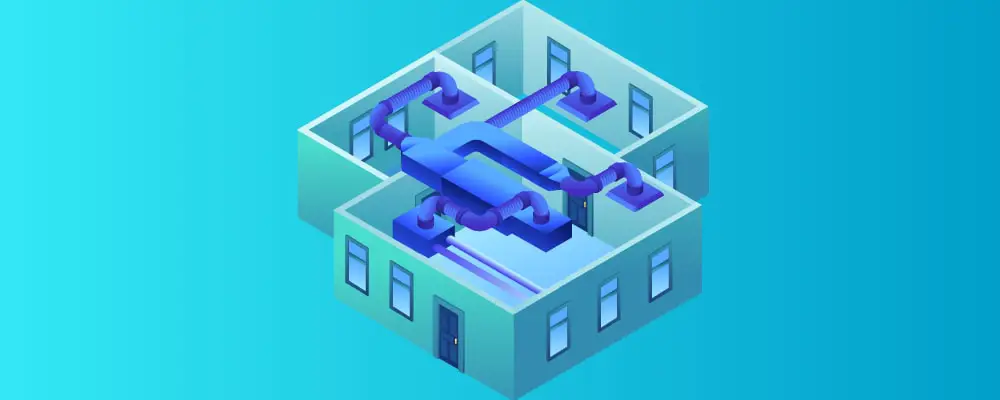
One of the most common questions we get asked is, what does HVAC actually stand for? Today we’re going to answer that question and much more for you.
What is an HVAC System?
HVAC stands for Heating, Ventilation, and Air Conditioning.
An HVAC system is a system that handles these three things in your home or business building. They are responsible for transferring heat and air around your home.
They keep you warm in winter, cool in summer, and move air in and out of your building. These systems can also be responsible for purifying the air in your home and preventing humidity build-ups.
How Can I Understand HVAC Systems?
HVAC systems are complicated. This complicated system is what makes them so useful, it a side effect of them being able to look after our homes so well.
Many people avoid learning about the HVAC systems in their building or don’t learn enough about them before having them installed.
However, spending a little time getting familiar with HVAC systems can save you a lot of time, hassle, and money in the long run.

People who can benefit from learning about HVAC systems
- Building supervisors
- Business owners
- Homeowners
- Renters
A Brief Introduction to HVACs
An HVAC system is responsible for the comfort of occupants in your home. When it is warm outside they keep you cool, when it is cold they raise the temperature of your home. On humid days they dehumidify. They also filter toxins and small particles out of the air, cleaning it before you breathe it in.
HVAC systems are traditionally made up of a combination of devices working in tandem to keep your home comfortable. This will often include air conditioning units, dehumidifiers, central heating, and air filtration systems.
The development of the first HVAC systems began in 19th Century America. Nowadays, the majority of complaints received by building supervisors are about malfunctioning HVAC systems.
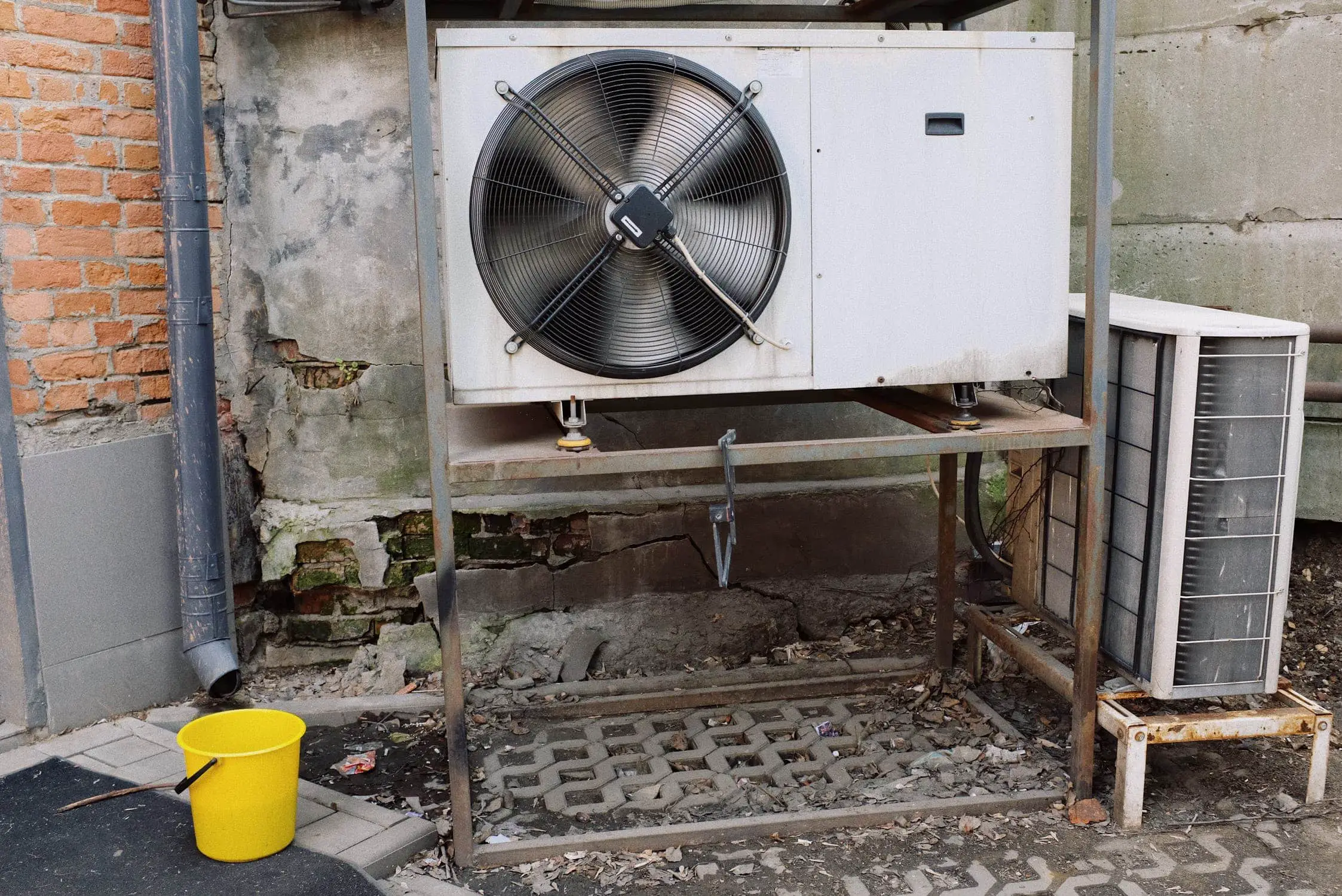
Further Reading
#1 – Check out this bite-sized HVAC introduction from Fire and Ice INC
#2 – Want to learn more about the history of HVACs, check out this from IAS
#3 – If you’re curious about designing your own HVAC system for your home (after you’ve finished reading this article, of course), check out this video from This Old House
Recap
What do HVAC systems do:
- Control central heating
- Control air conditioning
- Prevent humidity build-up
- Filter the air in your home
- Control your ventilation systems
- HVAC stands for Heating, Ventilation, and Air Conditioning
- Nearly all of us can benefit from learning more about HVAC systems
- HVAC systems can be traced back to the 19th Century
What Are The Basic Types of HVAC Systems?
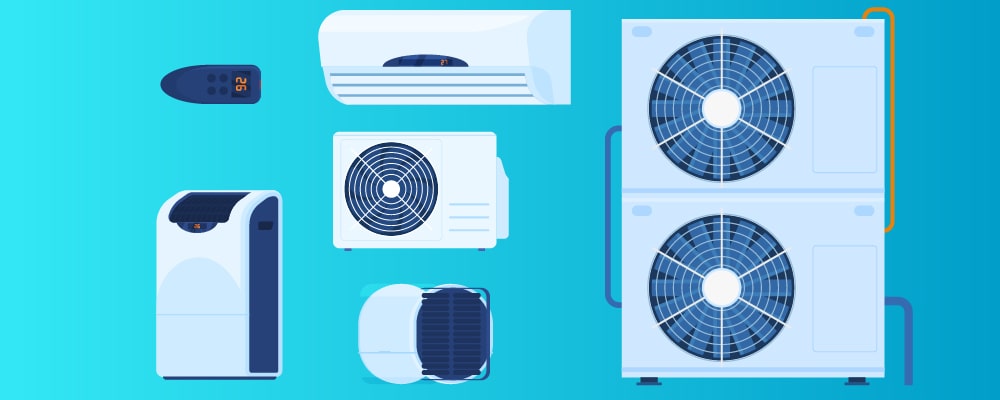
HVAC systems can be split into two basic types: Heating Systems and Cooling Systems.
Before making the choice about what your home or commercial building needs you should consider the following questions:
- What kind of fuel do you want your heating to use? Your options are generally: oil, coal, electricity, or gas.
- What type of ventilation does your building need? Do you need a dedicated ventilation system? Do you just require fans and louvers? Do you want a system that introduces outside air into your home?
- Do you need an air filtration system?
- What type of cooling system do you want to use? Chiller? Electric air conditioning system? Electric heat pump?
- How will this system work around the occupant’s lifestyles? Will you need an air ducted system? Or a series of radiators? Or perhaps a hydronic hot and cold water system?
- How energy efficient are these systems?
While your combination of answers won’t narrow down your choice to just one HVAC system (as there is almost an endless choice of HVAC options and combinations). The answers will help you work out what you don’t want, which in turn will make your choice much easier.
Let’s take a deeper dive into the two basic types of HVAC systems: heating and cooling.
Heating Systems
In most areas of the world, homes and commercial buildings require a heating system for at least a few weeks of the year.
Heating systems come in many shapes and sizes and most people will be able to choose a custom system that suits them.
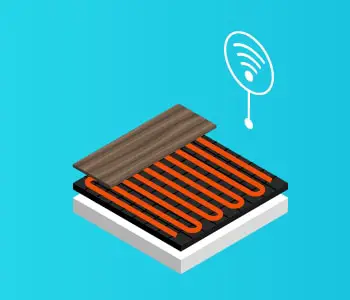
Furnace Systems
These systems work by burning material to heat the air around it, this air is then fed through a series of ducts around the building. These furnaces are generally powered by propane or natural gas.
Boiler / Central Heating Systems
By burning gas or oil these systems heat up water. The water can be used to heat the building in two ways.
It is turned into steam and used to heat steam radiators. It can also be part of a forced-water system which through heat pumps, baseboard radiators, and underfloor pipes brings warmth to the home.
Radiant Floor /Underfloor Heating Systems
These systems use flexible piping filled with glycol solution or water. The piping is installed under the floor.
It works with all types of flooring (including concrete and tile), it can also be retrofitted into wooden floors. This system is also known as Hydronic Heating. It is an incredibly energy-efficient system of heating the home.
Cooling Systems
Not all of us are lucky enough to need a cooling system in our homes. However, in those parts of the world that do require one, a good cooling system can be life-changing.
Just like with heating systems, there are many options of cooling systems available.
One Box Air Conditioning
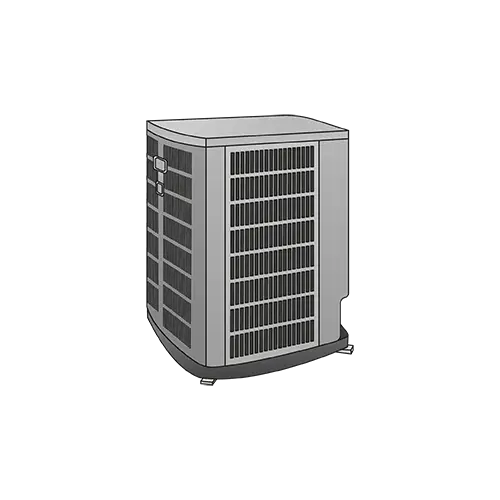
These systems are made up of one large box (relative to the house/building size) that cools the whole building. These are traditionally permanent and powered by electricity.
Window Mounted and Portable Air Conditioning
This system normally involves a small air conditioning unit that can be set up seasonally to provide cooling to a single room. It is possible to remove these boxes so they do not get damaged in the colder months. They are traditionally powered by electricity.
Evaporative Coolers
These systems are a great option for dryer climates. They draw in air from the outside and add moisture to it. This cools the air in your home and displaces it at the same time.
Split Systems
These are usually one of the options mentioned above, but they involve using air from the interior and exterior of your house. Because of that, they can be difficult to install, but they are inexpensive to run in the long term.
How Do They Work?
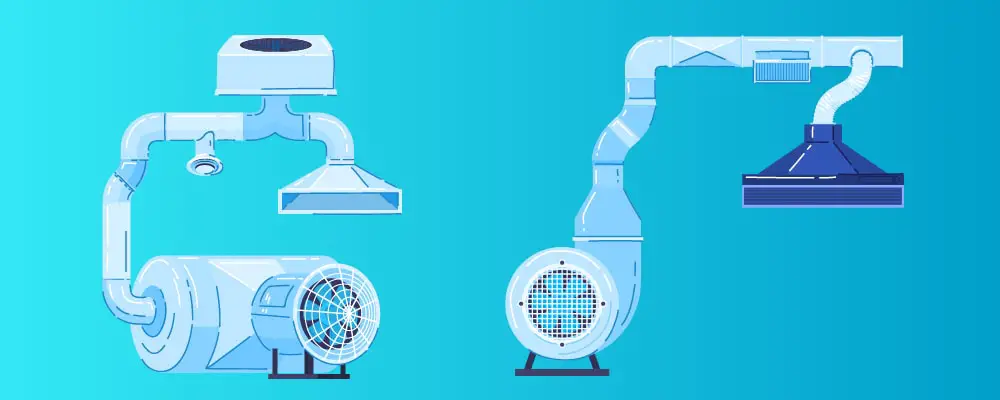
So, how do these systems work?
Before we go into too much detail, let’s refresh our knowledge on the 5 key parts of an HVAC cooling or heating system:
The Condenser is responsible for removing the heat from the refrigeration system, pushing outside the building.
The Evaporator is responsible for transferring heat from the air into the refrigerant. As a result of this, the refrigerant becomes boiling and starts to evaporate.
The compressor is the driving force behind the whole system. This is the part of the machine that creates the energy to move liquids and gasses (like steam and refrigerant) around the system.
The Expansion Valve creates a pressure drop inside the system by restricting its liquid or gas line.
The Receiver Drier, combined with a filter, removes any toxins and contaminants from the HVAC system. It is kept in the area where the excess refrigerant is stored. It prevents any unwanted build-up in this location.
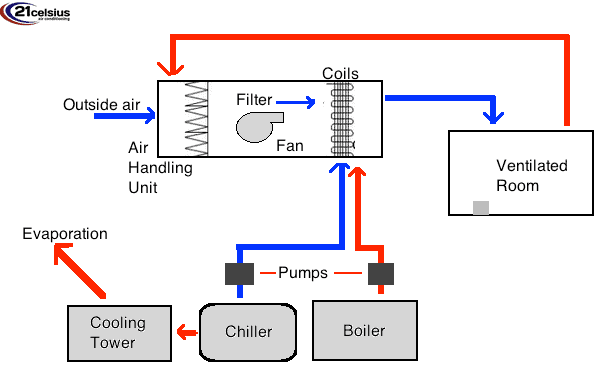
Other items your system may contain:
- Air return circuit
- Filters (don’t forget to change these regularly)
- Exhaust outlets
- Ducts
- Electrical circuits
- Outdoor units
- Coils
- Blowers
Now that we have covered the basics, let’s look at how these heating and cooling systems work.
Warning, the next section may feel a bit like a physics lesson as we’re going to have to talk about thermodynamics.
Air Conditioning and Air Distribution
The main aim of this type of cooling system is to draw heat out of your home and transfer it outside. The cool air that is made as a result of this is fed back into the house.
A central unit draws in the air, passing it over the surface of cold coils. The coils absorb the heat from the air and the cold air is fed back into the room.
A split unit is slightly more complex but is cheaper to run. The hot air is drawn into the unit where the refrigerant absorbs the heat.
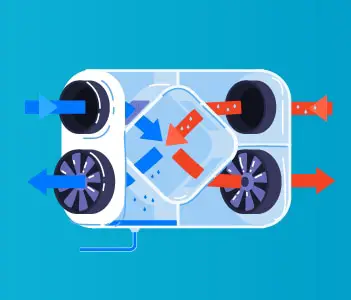
The Compressor then pumps the gas refrigerant into the outdoor unit.
Here it is cooled until it becomes liquid in the condenser. The heat is transferred outdoors. Some units will also draw cool air from outside at this point.
Everything is passed through the expansion valve, where the pressure is drastically reduced.
The air is passed over evaporating fins which absorb more heat. The cold air is returned to the room and the refrigerant returns to the compressor to repeat the cycle.
Heat Pumps
On a very basic level, Heat Pump systems work in a reverse way to the cooling systems we mentioned above.
The cold air from indoors or outside is drawn in, it is fed through the same system, however, the valve is reversed. The air is heated, and the cold is pumped into the outside world.
Some people find that a heat pumping system does not work well enough for them. With cold air inside and out it is often fighting a losing battle if it isn’t big enough for the room.
Therefore it is not uncommon to see both radiators and Heat Pumping systems in use together.
What is the Best Way to Combat Humidity?
The most efficient way to do this is to use an electric heater. When the humidity level in your home gets too high the heater will be triggered to switch on.
This raises the temperature and forces the air conditioner to run for longer. The longer it runs the more moisture it removes. However, this is very inefficient and can get very pricey, very quickly.
A more efficient method is to install a system that uses the waste heat from the air conditioner to lower the humidity levels in the room.
There are also many different types of HVAC systems that offer ventilation systems that can reduce the amount of humidity in your building.

Recap
The two types of basic HVAC systems are heating and cooling:Heating system options include:
- Furnaces
- Boilers
- Underfloor heating
Cooling system options include:
- Permanent wall boxes
- Portable window boxes
- Evaporative coolers
- Split systems The 5 key parts of basic HVAC systems are:
- Condenser
- Evaporator
- Compressor
- Expansion Valve
- Receiver Driver
- To reduce the humidity in your house try a space heater or ventilation system
What Are The Different Types of HVAC Operations?
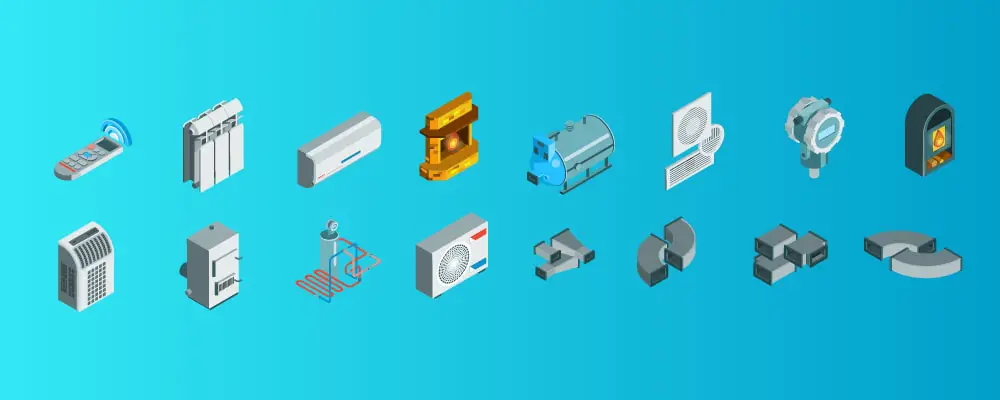
We have now covered the majority of the HVAC basics. Now, it is time to take a look at the different types of HVAC operating systems.
Whilst every system has its benefits, many of them are only suitable for specific situations. Be sure to explore each type of system before committing to one.
Heat Pumps
Heat Pump systems are really great for parts of the world where both a cooling and heating system is required throughout the year.
Heat Pumping systems are reversible and therefore can be used to both cool and heat rooms.
It is possible to get central heat pumping systems, however, most installers will recommend using a Split System. A heat pump draws in the cold air from outside, heats it up, and releases it into the room.
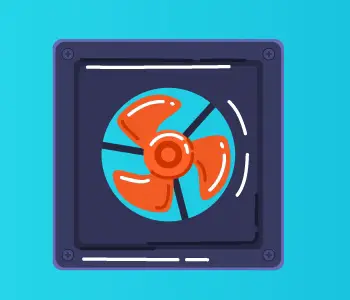
They are very efficient at heating small areas, and can be up to 4 times more efficient than other heating systems. When it is required to cool the room, the air is passed through the system in the opposite direction. The heat is expelled and cool air is returned to the room.
The downside to Heat Pumps is that they are less effective in larger rooms, particularly during the colder months. Many people have to supplement their Heat Pump with space heaters or radiators until the room has become warm enough.
In the colder months, Heat Pumps also require a small amount of time to warm themselves up so it can begin heating the room. The length of time this takes will vary depending on the model.
Rooftop Unit
Rooftop units are large types of HVAC units that are installed on rooftops. These units are also known as air handlers.
They are specifically designed for looking after large spaces, like whole buildings or big halls. Sometimes rooftop units are installed on the ground with smaller buildings.
These types of units are typically installed on top of commercial buildings or large blocks of flats. They will usually look like a group of grey plastic boxes on the roof of a building.
These boxes contain dampers, filter racks, chambers, blowers, and heating and cooling devices.
Rooftop units are large types of HVAC units that are installed on rooftops. These units are also known as air handlers. They are specifically designed for looking after large spaces, like whole buildings or big halls. Sometimes rooftop units are installed on the ground with smaller buildings.
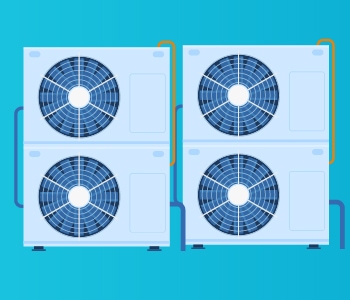
These types of units are typically installed on top of commercial buildings or large blocks of flats. They will usually look like a group of grey plastic boxes on the roof of a building. These boxes contain dampers, filter racks, chambers, blowers, and heating and cooling devices.
Often rooftop units will feed into a system of ducts, spread throughout the whole building. This is the most efficient way to transfer cooled and heated air around large spaces or multiple rooms.
Both the beginning and the end of the duct system are attached to the rooftop unit. When the air has completed one loop it is either discarded or filtered and fed back into the HVAC system.
The heating element of rooftop units is typically powered by a furnace (usually gas or propane powered). They will often use a split Air Conditioning system to cool air. This uses a fan to suck in cold air from the outside.
Many rooftop units are capable of supplying buildings with both heated and cooled air in different locations. This is one of their many benefits.
Other benefits include being low maintenance and easy to program.
On the other hand, these types of systems usually have only one control panel, and if broken the whole building loses its HVAC system. It is also worth bearing in mind that these ducts are very large, and will decrease the amount of available space in your building.
They are however the most cost-effective way to heat commercial units like office blocks.
Water Source Heat Pump
Many eco-homeowners chose to heat their homes using this method. The use of Geothermal Heat Pumps is particularly popular with the environmentally conscious.
This HVAC system can be incredibly energy efficient and cheap to run once it is installed. However, there is often a large upfront installation cost.
A Geothermal Heat Pump system draws its heat from under the ground, and most of the heat energy lost in the process is recycled back into the system.

This type of Heat Pump system does not require an external cooling system as most Heat Pump variants do. Many eco-homeowners chose to heat their homes using this method. The use of Geothermal Heat Pumps is particularly popular with the environmentally conscious.
This HVAC system can be incredibly energy efficient and cheap to run once it is installed. However, there is often a large upfront installation cost.
A Geothermal Heat Pump system draws its heat from under the ground, and most of the heat energy lost in the process is recycled back into the system. This type of Heat Pump system does not require an external cooling system as most Heat Pump variants do.
These systems can also be created by using a boiler to heat the water rather than a Geothermal source. Either way, the system is incredibly cost-effective.
The Water Source Heat Pump HVAC system is also known as a One Pipe System. The house will be split into zones, and each zone will have its own system.
The Heat Pump system pumps the hot water (roughly 80 F) around a loop pipe. The pipe passes through radiators or under the floor to heat the house.
The main drawback of this system is that all of the elements are stored inside the house. This means the system can’t always be fitted to older builds, and can often be very noisy.
Packaged HVAC
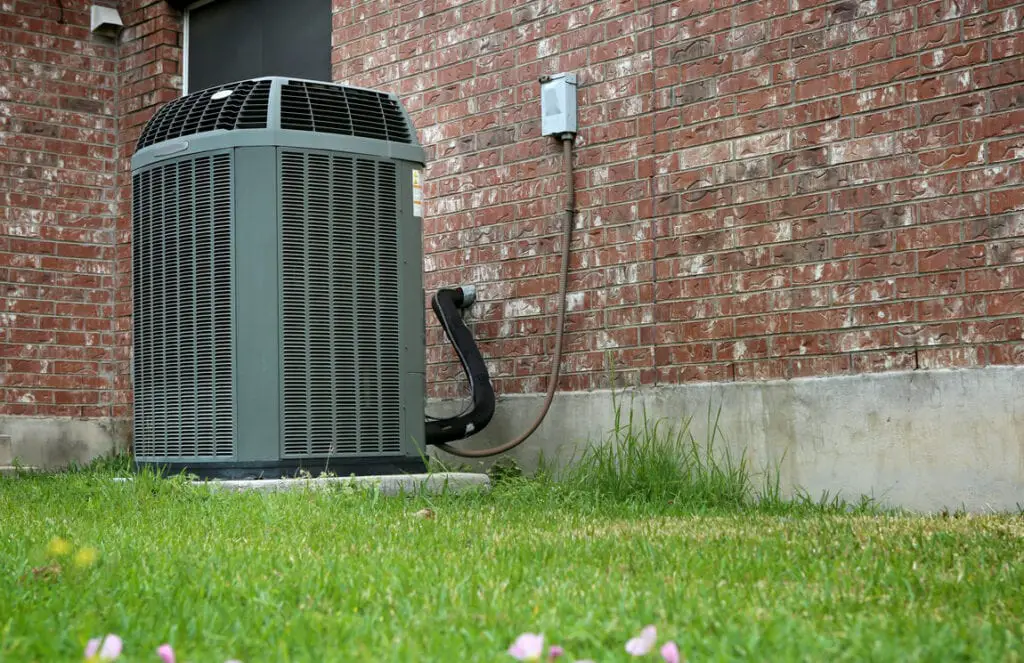
Packaged HVAC units are often confused for miniature Rooftop Units.
Whilst they are technically something different, they do fulfill the rough role of a small rooftop unit i.e. they do a similar thing on a smaller scale.
If you know a window Air Conditioning unit is too small for what you need, but a centralized cooling system is too large – check out Packaged HVAC.
Packaged HVAC systems are perfect for people who need something sized in the middle of these two systems.
Packaged HVACs come in two forms:
Water Cooled Condensers
These Air Conditioners use water to cool their condenser. These types of units are typically installed inside buildings as they need a constant supply of water. This water supply will prevent the AC unit from getting damaged.
Air Cooled Condensers
As you can probably guess by the name, instead of using water these units cool their condensers will air. These are more similar to Rooftop units, in that they have a fan to acquire the air. The fact that these units do not require a constant supply of water has led to them being more popular than Water Cooled Condenser Packaged HVAC units.
A Packaged HVAC system would be perfectly sized to support a medium sized family home or a smaller retail unit.
Split System AC
You will have seen the phrase Split System Air Conditioning a few times already in this article. Most Window Box Air conditioners, Rooftop units, and Packaged HVAC systems employ a Split System AC.
What is a Split System AC?
Split System AC is a unit where the heating and cooling functions are separate and can function in different areas. In a Rooftop unit, this would allow it to cool one floor whilst heating another.
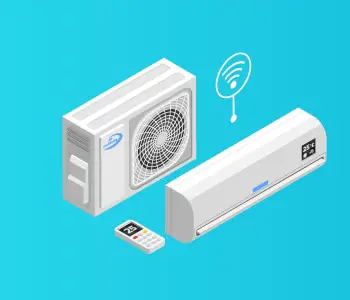
There are two main types of Split System AC:
- Mini Split, or ductless: as you may have already guessed this system doesn’t use ducts.
- Central System: this is a system that does use ducts. Rooftop units are a prime example of central systems. They are mostly designed around cooling. Through the use of multiple air-louver-control boxes, they offer temperature control across multiple ‘zones’. They are a great option for commercial spaces as if not all the zones are occupied some of the boxes can be shut down to save money.
Mini Split systems are most commonly powered by electricity, whilst the bigger central systems are usually powered by propane furnaces.
Ductless System

(Also known as mini-split systems)
These are the smallest form of HVAC. This is the best choice for anyone looking to regulate one large room or a series of small rooms.
Many people who are interested in getting a Packaged HVAC system installed find they only need a Ductless system.
For more information on how this system works, see above.
One of the major benefits of Ductless systems is you can enjoy an efficient HVAC system in your home without having to sacrifice space for it. No ducts are required inside the walls and the main body of the system can be stored outside. It can even be stored a small distance away from the building.
The majority of home Air Conditioning units are mini-split units. This system was designed with domestic uses exclusively in mind. No major restructuring is required to install these systems. It would even be possible to install this type of system yourself if you’re pretty handy with a screwdriver and power tools.
It is possible to have multiple mini-split systems running on the same HVAC circuit.
Recap
- Heat Pumps are great for smaller rooms. They can offer both heating and cooling solutions (but not at the same time).
- Rooftop Units are a great option for heating large buildings with many rooms (like a commercial office block). They use a combination of furnace-sourced and electrical power. They can supply warm and cold air simultaneously. Their ducts take up a lot of room in the building.
- Water Source Heat Pumps are an affordable and eco-friendly option. They can be powered by a boiler or Geothermal heat source. Multiple WSHP systems are required to heat one house. They recycle most of their lost heat.
- Packaged HVAC units are a great option for medium sized houses or smaller business premises. They function in a similar way to Rooftop units, but on a smaller scale. The most popular form of Packaged HVAC unit is the Air Cooled Compressor variant.
- Split System AC describes an AC system that can provide different zones with individual temperature control. Split System AC units can be found inside many different types of HVAC systems, including window box air conditioners and Rooftop units.
- Ductless Systems are also known as Mini Split Systems. They are a small type of Split System HVAC. They are a great option for installing in older buildings. They are perfect for maintaining a collection of small rooms or one larger room. They are easy to install, and they require very little building work.
What Are Rough Sizing Systems?

The trick to getting the perfect HVAC system for your building is to understand the volume of air you will need to maintain it.
In a medium office space or residential building, for every 1000 square feet* of space in the building, you will roughly need 3 tons of air produced by your HVAC system. Knowing this can help prevent you from overspending on an HVAC system that is more than you need.
Purchasing an HVAC system that is too big for your building will also result in much higher electricity bills.
The use of the building/set of rooms can cause this number to vary massively. Dedicated computer storage rooms need to be kept a lot cooler to counteract the heat produced by the machines. Larger residential buildings on the other hand can get away with using a much milder HVAC system
*(1000 sf / 350sf/ton = 3 tons)
Below we have put together a rough guide to the volume of air different types of buildings need:
|
Type of Building |
SF/Ton |
|---|---|
|
Classroom |
250 |
|
Industrial Building |
300 |
|
Arena |
200 |
|
Conference Room / Office |
150 – 250 |
|
Retail |
350 |
|
Computer Room |
50 |
|
Residential |
750 |
Following this guide, if you wanted to install an HVAC system for a series of computer storage rooms the sum (with the total area of 1000 square feet):
1000 square feet / 50 sf/ton = 20 tons of air per 1000 square feet
These numbers will vary depending on the size of the rooms. However, this table is a great resource for doing a rough estimation.
If your build has a pre-existing series of ducts then you may need to have them adjusted. Older duct models are often bigger than they need to be. By making them more compact your system will run more efficiently. Talk to your contractor about their reviews on the duct systems.
Recap
Finding the perfect sized HVAC system can save you a lot of money in the initial purchase and in the long run.
What is HVAC Energy Usage?

The amount of energy used by a HVAC drastically affects how cost effective it can be to run. So HVAC systems may be cheaper to install, but in the long run you lose out on the utility bills.
The price of these systems per week or per month can vary for many different reasons.
The first factor that contributes to the price of running an HVAC system is the size of the area the HVAC controls. The larger the area, the larger the cost. If you have the right size system for the building installed, it will be much more cost effective, particularly in larger commercial buildings.
The second contributing factor to the price of running an HVAC system is the type of fuel used by the HVAC. Electricity is the most expensive way to fuel these systems, closely followed by LGP systems, then coal and oil. Gas is by far the cheapest method for power generation with an HVAC system.
A great example of this is the difference between powering heat pumps by gas and electricity. Gas run heat pumps cost around $800 a year to run, using oil would cost around $900. If you used electricity to power your Heat Pump it would cost you nearly $3000 a year.
The exception to this rule is electricity that is produced in a renewable way at home, or on your business property. After the initial installation costs, using your own renewable energy can be a great way to save money. And it helps the environment.
It has also been suggested that onsite, geothermal HVAC could save consumers a lot of money. However, these systems only work on a small scale. A larger commercial premise could require dozens of geothermal water pumping systems.
The final contributor to the cost of running an HVAC system is the age and quality of that system. HVAC units traditionally have a lifespan of 20-25 years.
By the time the HVAC reaches 12 years old, it becomes 20-40% less efficient on average. If the SEER rating of your unit passes above 20 then you can make massive monthly savings by replacing it.
Older models are more likely to break and will need a lot more maintenance. They also tend to be worse for the environment.
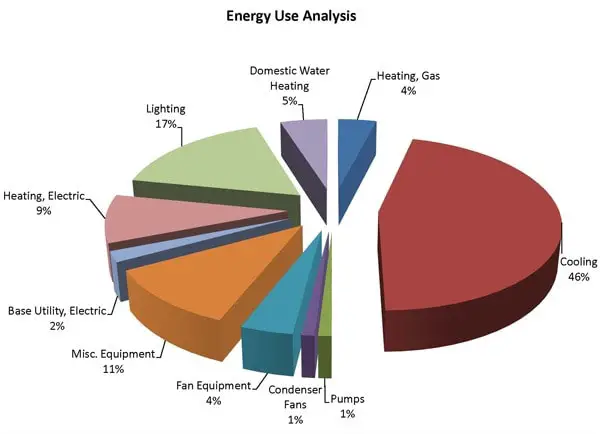
Recap
There are three main factors that affect the cost-effectiveness of an HVAC system: age, fuel, and size.
The larger the machine the more expensive it is to run. Make sure the machine is the right size for your building.
Gas is the cheapest form of fuel. Electricity is the most expensive. Unless sourced renewably by yourself.
The older the HVAC the more expensive it is to run. These systems last for around 25 years, by the time they reach 12 years old they can be up to 40% less efficient.
What Effects Do HVAC Systems Have on the Environment?
The main environmental concerns when it comes to HVAC systems is their use of refrigerant and their intensive energy use (which we covered in the section above).
What Effect Do Refrigerants Have on the Environment?
Refrigerant 22 (R-22 or MonoChloroDiFluoroMethane, CHClF2) was invented in the 1950s and had become one of the most commonly used refrigerants in the U.S. After heavy testing and protests all over the world the refrigerant was banned, and companies began phasing it out of use in 2003.
This did not happen soon enough and it was eventually proved that R-22 had a role in damaging the ozone layer around the earth.
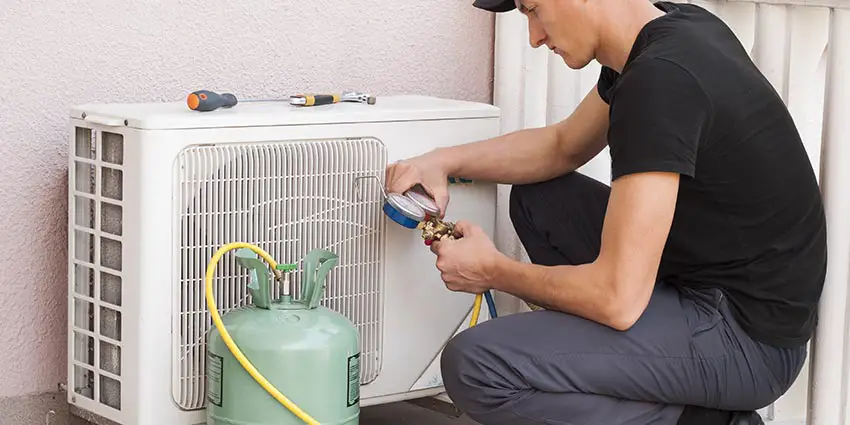
Whilst other refrigerants aren’t as harmful as R-22, they’re certainly not innocent. They can cause harm to local plant life and should never be ingested.
The ‘greenest’ HVAC system is undoubtedly a Water Source Heat Pump that is powered geothermally. This requires little to no electricity and does not burn oil or propane. This is a system that also doesn’t use refrigerants.
Electricity and Renewable Energy
Many HVAC systems run on electricity and would have no issue in converting to electricity produced from renewable sources.
For these systems, using electricity has less of an impact on the environment than their use of refrigerants.
In years to come, when our society becomes more reliant on green, renewable energy for their national grid the carbon footprint of HVAC systems will dramatically shrink.
Oil and Propane
Whilst it is common knowledge that burning fossil fuels like oil can have a negative impact on the environment, propane’s impact is rarely discussed.
Not only is propane a lot cheaper than oil (although oil prices do fluctuate greatly), but it is a ‘clean burning’ gas. What does that mean? Well, unlike oil, which releases a lot of CO2 when burned, propane does not release anything harmful.
There are environmental drawbacks when it comes to acquiring propane but it is a much better choice than oil if you’re looking to reduce your carbon footprint.
Recap
Many HVAC systems will have a small impact on the environment around them. Some refrigerants can release harmful gases, and using oil or propane gas can also have a negative impact on the environment.
If you are looking for a carbon-neutral HVAC system, try a Geothermal Water Source Heat Pump. Or using renewable energy to power your HVAC system.
Conclusion: What’s the Right Fit For Me?

When looking for a new HVAC system everything can seem overwhelming. It is a very complicated subject. However, by learning a small amount about the subject you can save yourself a lot of money.
Every building, company, house, and family has different requirements for their HVAC system. The good news is that there is a huge range of HVAC systems out there. And with the help of this article, you will be able to pick out the right fit for yourself.
Before you begin this process you should gather the following information:
- The square footage of your house / commercial building
- How much work can be done on your house / commercial building
- What HVAC system is currently installed if there is one
- You should decide at this point how eco-friendly and wallet friendly you would like your HVAC system to be
By gathering this information you should be able to narrow down the type of HVAC system you need.
Small rooms can get away with Ductless Systems (also called Mini Splits), whereas a large shopping complex or office building will most likely require a Rooftop unit with an extensive duct network.
Many older houses won’t be able to install systems with ducts, as their walls will be too thin, or extending the walls will result in a lot of loss of living space.
Gas and geothermal options are great for the wallet and the environment. But the most cost effective method of running an HVAC system is to install your own solar panels to power it.
With this beginner’s guide to HVAC systems at your side, we’re confident that you’ll be able to find the perfect HVAC for your home or business without a problem.
